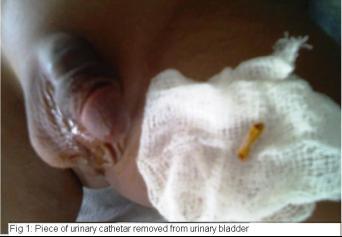Naresh Tayade, Hement Murkey.
Pediatric Department, Ayushkam Bal Rugannalaya Amravati, Maharashtra, India.
ADDRESS FOR CORRESPONDENCE
Dr. Naresh Tayade, Meghdoot Nagar, Near Amar Colony, Amravati (Maharashtra), 440606, India.
Email: nareshtayade@yahoo.co.in | | Keywords | | Foreign body, Urinary bladder, Recurrent UTI | | | | Keywords | Three years old boy was admitted to our hospital with history of recurrent pain and burning micturation along with passing red color urine. No family history of renal stone, hematuria or deafness was noted. There was no fever. He was completely all right till 2 year of age when he first suffered from dysuria and passing red colored urine for which treatment was taken from a local doctor but symptoms had not decreased so was admitted at a hospital. Details of investigations done at that hospital are not known, however a urinary catheter was placed for 12 days. After discharge from the hospital, he again got recurrent pain during micturation along with passing red colored urine. The attack was relieved by medications but again reappeared every 2-3 months. He also underwent circumcision for the same. On examination, during passing urine, he was in agony with pressing at base of penis and passing red urine with good stream. There was no bulge or swelling noted at the penis. Systemic examination was normal. Urine routine and microscopy showed presence of 25-30 pus cell along with 80-90 RBC/ hpf and traces of albumin. Ultrasound (USG) abdomen showed thickening of urinary bladder suggestive of cystitis. Urine calcium to creatinine ratio was <0.2. Hemogram showed anemia with hemoglobin of 8.3g/dl, total white cell count & differential count were normal with normal platelets. Due to pain at base of urinary bladder, a cystoscopy was done which showed presence of part of catheter in urinary bladder which was removed. Post procedure course was uneventful and on follow up after 15 days, child is well with no complains.

Whenever there is recurrent cystitis we have to find out predisposing cause for it. Though rarely described in children, foreign body in bladder may be the cause for it for which high index of suspicion will be required. Sometimes it can be missed on USG; in such cases cystoscopy may be useful for diagnosis as well as treatment (1). As per definition in NICE Guideline 2007 recurrent UTI is defined as 1 episode of pyelonephritis/upper urinary tract infection (UTI) plus one or more episode of UTI with cystitis or lower UTI or > 3 episodes of UTI with cystitis/ lower UTI (2) . In any child with recurrent UTI, identification of predisposing factors is required but most of pediatric book doesn't mention foreign body as a cause of recurrent UTI. Iatrogenic cause is common but in some it may be self introduced in psychiatric illness or for sexual gratification, or migration from other place (3). In our case it is iatrogenic. There are varieties of objects which can be detected as foreign body like part of Foley's catheters, broken stent of cystoscope, filiform guide, suture material, gauze piece, fragments of endoscopic instruments other things like metal wire, hair pin, thermometer etc (1,3,4). Two types of symptom complex may be present with this, one as acute retention of urine or one with chronic dysuria, hematuria or recurrent UTI in which cause may be unknown for the years in absence of positive history. In 2nd type the patient most commonly present with dysuria or urinary frequency (4). Our patient presented to us with dysuria and hematuria. Complications of intravesical foreign body consists of chronic and recurrent UTI, acute urinary retention, calcification, obstructive uropathy, scrotal gangrene,vesicovaginal fistula, squamous cell carcinoma and even death due to sepsis (5-8). The diagnosis can be on X-ray if object is radio-opaque or by USG if not radio-opaque. Sometimes, USG can miss the foreign body in that case cystoscopy may be diagnostic and of therapeutic value (1). Now with modern techniques most of the foreign bodies are removed transurethrally (1,3,4), as was done in our case. Sometimes open surgery may be required. | | | | Conclusion | We are discussing this case as to create awareness that after removal of any catheter one should look that whether it is broken or not. For any persistent or recurrent dysuria or hematuria without any predisposing factors, we have to suspect foreign body along with other causes.
Contributors: Both authors were involved in management and diagnosis of patient. NT done the drafting of manuscript and literature review while HM revised the manuscript and will serve as guarantor.
Funding: None
Competing Interests: None | | | | Compliance with Ethical Standards | | Funding None | | | | Conflict of Interest None | | |
- Rafique M. Intravesical Foreign Bodies Review and Current Management Strategies. Urol J. 2008;5: 223-231. [PubMed]
- Mori R, Lakhanpaul M, Verrier-Jones K. Diagnosis and management of urinary tract infection in children: summary of NICE guidance. BMJ. 2007; 335: 395-397. [CrossRef]
- Mannan A, Anwar S, Qayyum A, Tasneem RA. Foreign bodies in the urinary bladder and their management: a Pakistani experience. Singapore Med J. 2011; 52: 24-28. [PubMed]
- Shaikh AR, Shaikh NA, Abbasi A, Soomro MI, Memon AA. Foreign bodies in the urinary bladder. RMJ 2010; 35: 194-197.
- Bapat RD, Kamdar MS, Bhaktiani K, Jathar H. Obstructive uropathy due to a vesical calculus around a foreign body. J Postgrad Med. 1981; 27: 51-52. [PubMed]
- Bhatt RI, Lau M, Ramani VAC. Renal failure secondary to a foreign body in the bladder. BJU International 2001; 88: 644.
- Mhiri MN, Amous A, Mezghanni M, Rekik S, Smida ML. Vesico-vaginal fistula induced by an intravesical foreign body. Br J Urol. 1988; 62: 271. [CrossRef]
- Wyman A, Kinder RB. Squamous cell carcinoma of the bladder associated with intrapelvic foreign bodies. Br J Urol. 1988; 61: 460. [CrossRef]
DOI: https://doi.org/10.7199/ped.oncall.2012.63
|
| Cite this article as: | | Tayade N, Murkey H. FOREIGN BODY IN URINARY BLADDER. Pediatr Oncall J. 2012;9: 106-107. doi: 10.7199/ped.oncall.2012.63 |
|